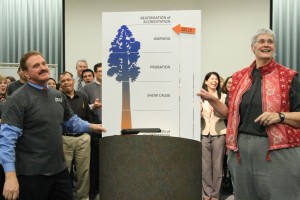
On Monday, February 10, staff and students were told that after a year’s work, the College of the Sequoias was taken off of ‘show cause’ status and put on ‘warning,’ a much less severe status.
The ‘warning’ status is the least serious the Accrediting Commission for Community and Junior Colleges (ACCJC) is able to give; though the name is foreboding, it is a significant improvement for the college, whose ‘show cause’ status was one step above revocation of accreditation.
Though newly appointed COS President/Superintendent Stan Carrizosa announced that the college was removed from Show Cause sanctions the week before the announcement, members of the college community were still unsure of what status the ACCJC awarded the college before Monday’s announcement.
In stark contrast to the same type of announcement last year – in which Carrizosa said that the show cause notice was, “the worst thing that would ever confront College of the Sequoias,” the mood was cheerful and celebratory; an internal forum opened with members of the college’s “Accreditation Response Task Force” dancing into the college’s lecture hall to Pharrell Willams’ song “Happy.”
“Based on where we were a year ago,” Carrizosa told the audience, “this is the very best that we could have hoped for.”
“I don’t think you can imagine doing any better than this.”
He told the Voice as much last year.
“The best we can realistically hope for is being placed on ‘probation’ [a status more serious than ‘warning’],” Carrizosa said in August, “or having our Show Cause extended.”
Only three recommendations remain for the college to address in the ACCJC’s new report. They all revolve around the college completing its new governance procedures.
Planning — The ACCJC created a fresh 2014 Planning recommendation, replacing the old planning recommendation. The team recommended the college fully follow its newly created COS 2.0 Model for Integrated Planning, showing “integration of institutional planning, resource allocation, implementation and re-evaluation.”
Research Capacity — The visiting team stated: “…in order to fully meet Standard IV.B.2.b [ensuring that data, research and analysis are guiding planning at the college], the College must demonstrate during its next evaluation cycle that data continues to guide effective planning, assessment, and decision-making.”
Evaluation of Processes — In the Show Cause team report, the visiting team relates this to the aforementioned Planning recommendation.

Photo by Daniel Nunez
“Instead of there being seven recommendations and 38 different standards [cited, as in the original Show Cause report], there are three recommendations that remain and there are the related standards that go with those,” Carrizosa said.
The college put significant effort into meeting each of the ACCJC’s recommendations and standards. It hired two consultants, assembled teams from across the college, and had sets of staff and students work tirelessly throughout the past year – and some throughout the summer break – to implement new programs, create “COS 2.0” manuals, and ensure the college’s compliance.
The college also purchased software to help meet Student Learning Outcome goals and meet standards for equitability of services for online and on-campus students.
During a campus-wide forum last year, Carrizosa said the college had earned praise for its strategies from as high as the Chancellor of California’s Community Colleges, Brice Harris.
“The word out among community colleges is that we should bottle how they’re doing it at College of the Sequoias, because that’s the process that people should be looking at to model,” Carrizosa said, quoting Harris.
During the February 10 forum, Thea Trimble, president of the college’s Academic Senate, spoke about a recent accreditation conference she attended. At the conference, representatives from Cuesta College – a college that COS looks at as a model for its accreditation, and has sought help and advice from throughout the last year – spoke about their experience going from Show Cause to full reaffirmation.
“To a person, they described how much better they are for having gone through this experience, how much better their processes are, how much better they understand how to work together, and how to get through difficult times,” Trimble said.
“I want us to hold on to that. They’re a year out from us. We’re going to be right where they were when we go to that accreditation institute next year.”
The college needs to continue to follow its “COS 2.0 internal processes to prove to the commission that it has fully embraced and adopted the recommendations handed down by the ACCJC in its initial Show Cause report and in the new Warning follow-up report.
Administration and faculty are confident that the college will achieve full reaffirmation, and are looking forward to the future. To achieve full reaffirmation of accreditation, the college must submit a report this October to the ACCJC.
“I think that we [the college community] are very proud of the work that we’ve done,” said Trimble, “and how we came together to get it done.”
